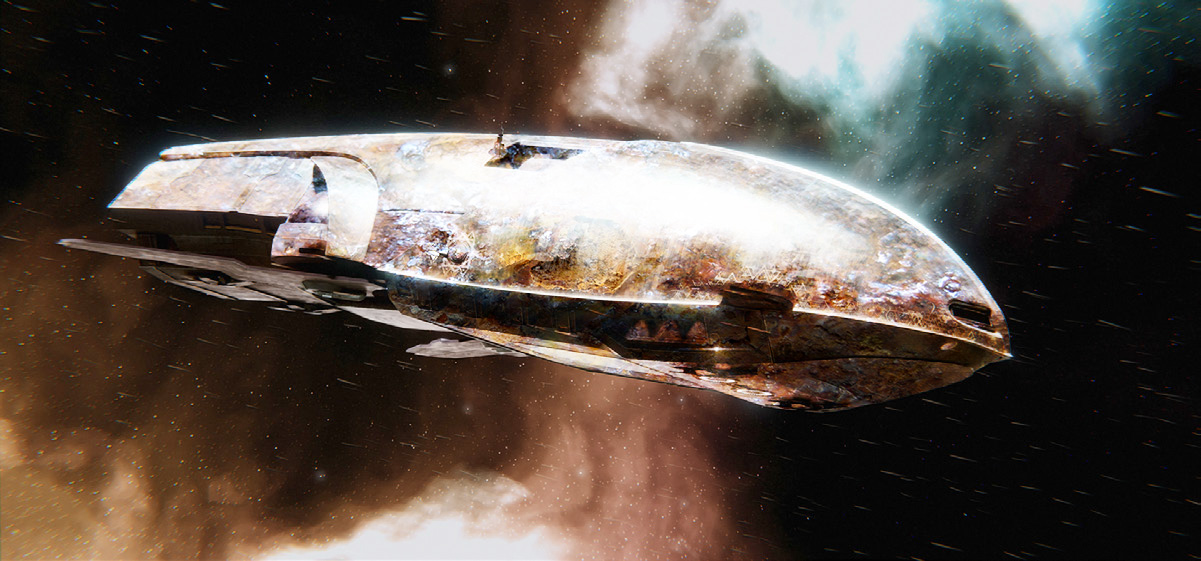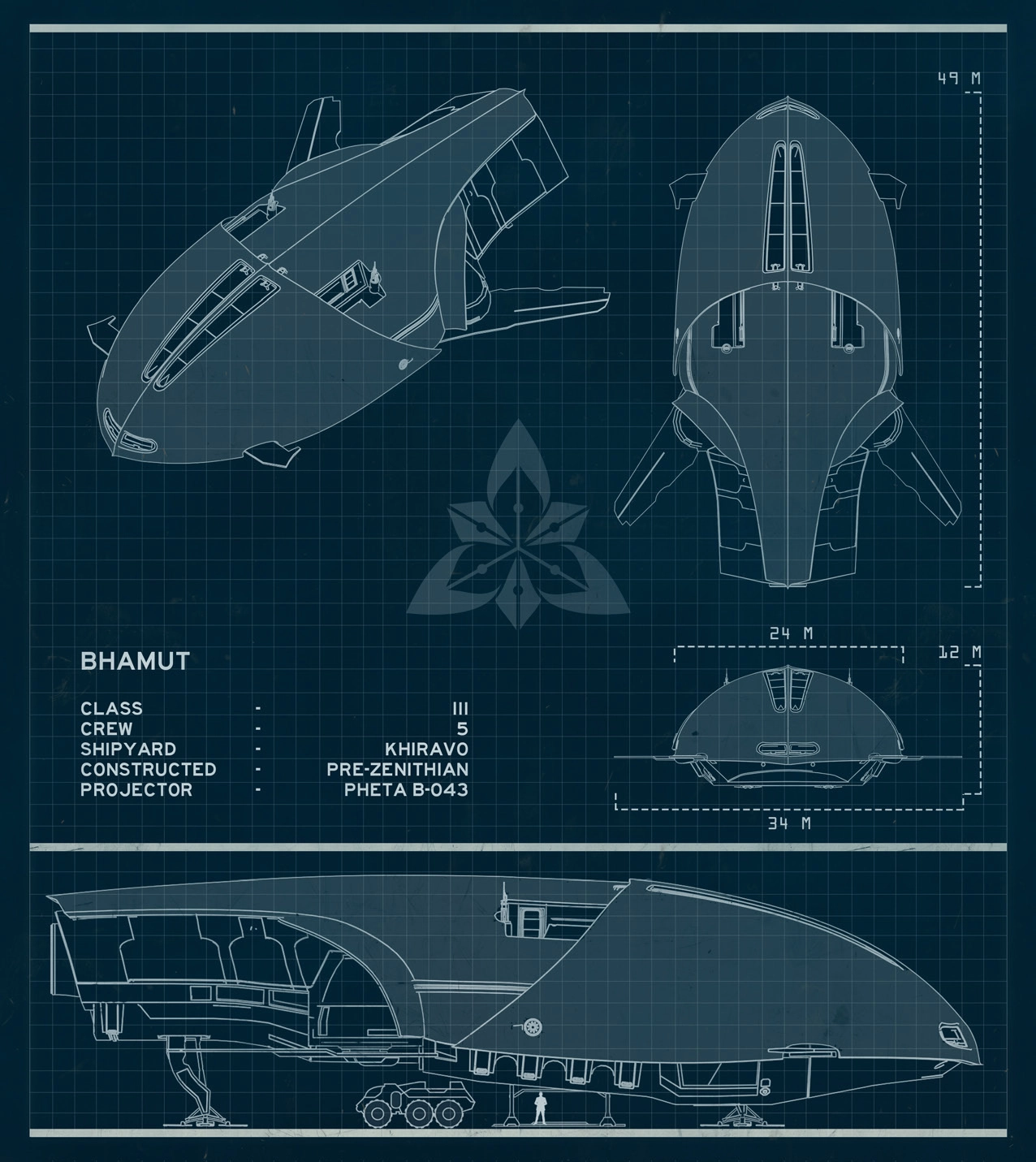Bhamut class
Black Moth
If someone is familiar with this old, obscure and exceedingly rare ship, chances are they learned about it from the works of Bijan Zandi. Zandi was a prospector turned artist who was part of a crew that discovered a seemingly abandoned spaceship in the iron deserts of Raqus in the Erequ system.
Although described as abandoned, the run-down ship occasionally served as a place of refuge and worship for a group of humanite settlers that called that barren landscape their home. Some of them can be seen standing next to the monumental hull as it catches the starlight in the painting titled Bhamut, one of Zandi’s most famous works.
It has since been established that the Bhamut, like the slightly more common Tanapur, heralds from the lost shipyards of Khiravo. The lack of a verified designation for the model has led to the widespread use of the name given by Bijan Zandi in CC 14. The motif of the painting, and how it came to be, has become just another chapter of the mystery surrounding the forgotten shipyard. However, the larger size of the Bhamut compared to other known Khiravo ships has led some to reevaluate both the historical significance of the Khiravo shipyards and the chances of actually finding it.
Skills
Khiravo Shipyard
The notion of a Firstcome colony big enough to con-struct its own space ships, yet small enough to vanish in The Long Night and fade from the memory of the major Firstcome factions has unsurprisingly stirred up some interest among researchers and historians. A Foundation-sponsored study of the ornamentations and markings of a decommissioned Tanapur corvette carried out in CC 54 concluded that there are some similarities to artifacts found in the remote Dziban system. The archeologist Nisrine Fasaal, who partook in this study, is said to have embarked on an expedition to confirm this theory, but no further evi-dence has been uncovered as of yet.
Upper deck
On the highest deck the walls and floors are mostly undisturbed by protruding pipes and structural elements, making it the most presentable part of the ship. Coincidentally, this is also where the main airlocks are. With close access to the chapel, the basic but elegant audience chamber, and a small security office, this area is perfect for entertaining guests at a safe distance from the operational parts of the ship.
Main deck
Large and busy, the middle deck houses most of the facilities and systems onboard. The bridge itself is located at the very front of the ship, lowered slightly from the rest of the deck. To provide better vision outwards it is usually in darkness when the ship is operated, lit only by screens and control panels. Behind the bridge is the main corridors, which forms a circuit around the stasis module and the crew quarters, and also leads to the reactor cham-ber and engine room in the stern of the ship.
Lower deck
This is largely an open space for cargo, surrounding the hangar in the middle. There are cargo doors on either side of the cargo hold, but they lack air-locks and can only be used in atmosphere. Tucked away in the back is a small workshop and an unpressurized ser-vice module that can be accessed from outside the hull through a hatch if needed, for the purpose of repairs.
Bhamut Pilgrim
Pre-Zenethian expedition vessel
CLASS: III
SHIPYARD: Khiravo, Dziban system (rumoured).
TIME OF CONSTRUCTION: Unknown (pre-Zenithian).
CREW: 5-6, with accomodation for 8.
STASIS PODS: 8.
SIZE: Length 49 m, Width 24 m (max wingspan 40 m), Height 12 m (14 m with landing gears fully extended).

Black Moth
Specifications
ENERGY POINTS: 6
HULL POINTS: 6
MANEUVERABILITY: -1
SIGNATURE: ±0
ARMOR: 6
SPEED: 2
FEATURES: Supercharged Reactor, Atmospheric Entry, Blessed Ship.
MODULES: Docking stations, Chapel, Hangar, Medlab, Cabins (2 standard, 6 coffins), Cargo Hold, Stasis Hold, Workshop, Service Station, Weapon System (Ion Cannon).
PROBLEM: Varies.
COST: 1 546 875 Birr

One central feature of the Bhamut is the hangar located on the underside of the ship, with an extendable vehicle platform that is perfect for deploying crawlers, grav crafts or ground loaders to a planet surface. Or, it can house and deploy a compact fighter or shuttle for use in space.
Another feature are the two docking ports, one on each side. They have what can only be described as balconies, offering some degree of utility and protection during space walks, but perhaps more useful as vantage points when the ship is landed. In larger space harbours, this is where a landing bridge would attach, while the cargo doors and hangar platform on the lower deck would be reserved for strictly logistic purposes.

